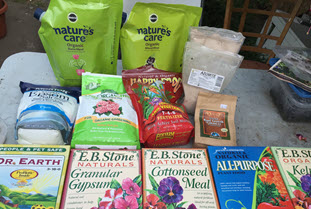Tomatoes are very strong a nd resilient plants. They are vigorous and hard to kill, however they have certain considerations that can make a huge difference in its success or failure. Here are a few tips for optimal growing:
nd resilient plants. They are vigorous and hard to kill, however they have certain considerations that can make a huge difference in its success or failure. Here are a few tips for optimal growing:
1. Tomatoes benefit from deep planting, so when you plant them in the ground or containers remove the lower 1/3 leaves and branches from the plant and burry the stem deep. The hairy protrusions along them stem have the capacity to turn into roots.
2. Amend the soil with rich organic matter like compost and manure. Also provide organic fertilizer in the planting hole to give the plant plenty of nutrients to support it through all stages of development.
My amendments include: Tomato/vegetable food, a fruit and flower fertilizer, bone, blood, kelp, alfalfa, cottonseed, & fish meal, azimuth, grape seed compost, lime, gypsum, and oyster shell. Some people like to plant a fish head, a whole banana, egg shells, aspirin, and tums in the hole too. Others swear by adding baking soda and powdered milk.
3. A good source of calcium (such as oyster shell, garden lime and gypsum, or pulverized egg shells) should also be added to lessen the possibility of the disappointment of blossom end rot.
4. Tomatoes benefit from pruning the plant to grow with one or two main stems by pinching out the offshoots that grow between the branches and main stem (known as suckers). This method is said to increase the size and flavor of the fruits.
5. In the first month after transplanting consider a weekly foliage feeding of diluted fish emulsion and Epsom salt to promote healthy leave and root growth.
6. At the first sign of flowering, switch to a phosphorus based fertilizer to promote flower production.
7. While tomatoes will often self pollinate, it doesn’t hurt to help them if there is a shortage of bees. You can go outside and shake the branches every morning or use an electric toothbrush along the back side of the flower to force the pollen to the stamen. Optimal temperatures for successful fruit-set is daytime temperatures between 70-85 degrees followed by evening temperatures of 50-70 degrees. Temperatures outside of that range will result in flowers dropping and lower yields.
8. Tomatoes are heavy feeders – they are pigs and need a lot of food throughout the growing season. It is not unusual to need to provide fertilizer 3 or more times a season (every 3-4 weeks) as the plant is in a constant cycle of flowering, setting fruit, and continual plant growth. You can add the fertilizer to the base of the plant along a 3 inch radius to avoid burning the root system.
9. A good support system is essential for overall plant vitality and preventing damage to the plant from heavy fruit. A tall stake, trellis, or cage are good options for keeping the plant leaves and stem off the soil, as tomatoes are very prone to soil born diseases when the leaves come in contact with the soil.
10. It is also recommended to remove all plant growth from 10-15″ from the soil level to create a barrier from the diseases that may be lurking in your soil.
11. A regular spraying down of the plant with organic pest protection as a preventative measure is ostentatious. Equal parts (1tsp per gallon of water) of Neem oil, baking soda, and Doctor Browners soap is a good option for both pests and garden mildew that arrives in late summer. It is important to spray in the early evening after the sun has passed overhead to prevent burning the plant.
12. Keep an eye out for the pesty ‘tomato horn worm’ (which can do great damage in little time). You will have to remove them by hand.
* Watering methods and considerations:
Tomatoes do not like to be wet, in fact watering from above is a sure way of causing problems with your tomato plants. Try focusing water directly towards the soil instead of hosing down the entire plant. Water evenly and consistently – perhaps 2-3 times per week. For best tasting fruit, cut back on water as fruits begin to ripen, and certainly do not water for 3 days before harvesting fruit. Harvest fruit early in the morning rather than later in the day.
————
Copyright © 2016-2020 The Garden of Eat’n